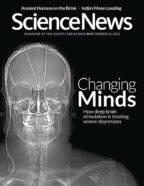This post was originally published on this site
Rethinking healing
Western colonists’ seizure of Indigenous lands and subsequent abusive assimilation efforts continue to harm and traumatize Indigenous people, leading to high rates of mental illness, chronic disease, incarceration and suicide. Psychologists are researching whether mental health programs founded on Indigenous traditions can help these communities reconnect with their culture and heal, Sujata Gupta reported in “Culture aids Indigenous mental health” (SN: 9/23/23, p. 14).
The story resonated with reader Gary Seeman. “I retired from psychological practice not long ago and was rooted in [Carl] Jung’s analytical psychology and Buddhist and Indian spiritual practices. All of those approaches helped me with clients and provided the depth needed for my own personal healing.”
Mental health programs founded on Indigenous cultural practices, such as welcoming spirituality and a heartfelt connection to the land, can only help Indigenous people, Seeman continued. “Encouraging such profound wholeness may be what is required to start to progress against the horrendous intergenerational trauma that Indigenous peoples have suffered. What you’re describing goes beyond the whole person to include the whole planet, something the rest of us must learn if we are to avert even more catastrophe.”
Discussing depression
Deep brain stimulation, a technology that pulses electricity into the brain, is providing relief to some patients with severe depression, Laura Sanders reported in “Lifting depression with brain implants” (SN: 9/23/23, p. 16).
“Thank you for reporting on deep brain stimulation with such compassion for patients and families,” reader Kevin Cole wrote. “I particularly appreciated your nuanced discussion of stigma.” Many people with severe depression and other mental illnesses, including one of Cole’s family members, experience stigma and other roadblocks in their daily lives.
Reader Ellen Leff appreciated Sanders’ thorough coverage. “The in-depth report of patients’ personal experiences in the article and the online videos brought much depth and perspective to the topic.”
Watch these videos and read the full series.
Make some noise
A platform made of clay, sand, ash guano and other materials discovered in the Andes may have been used by the ancient Chocorvos people to worship a thunder god. Dancing and stomping on the platform would have produced a thunderous boom, Bruce Bower reported in “Ancient platform drummed up thunder” (SN: 9/23/23, p. 13).
Reader Lynn Allen found the article fascinating and was reminded of the way valleys can sometimes funnel and carry sound over vast distances. “I live in New Mexico on a hilltop and enjoy hearing clear conversations from across the hill and other sounds that travel clearly and far,” Allen wrote.

